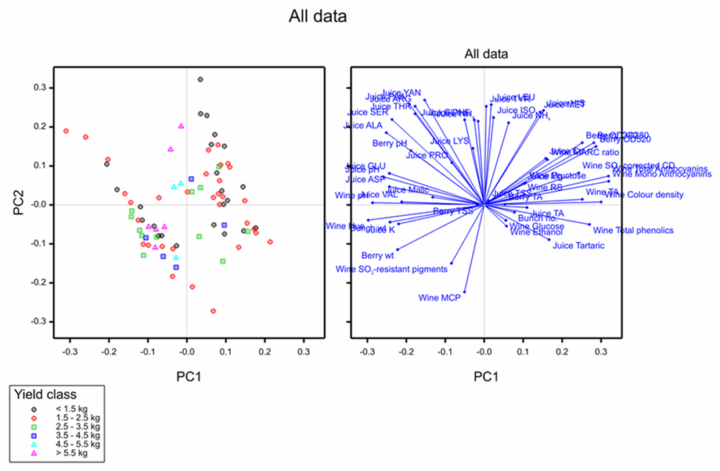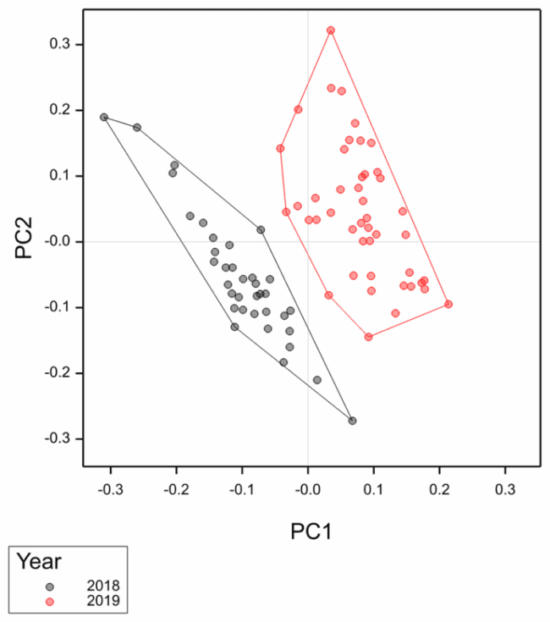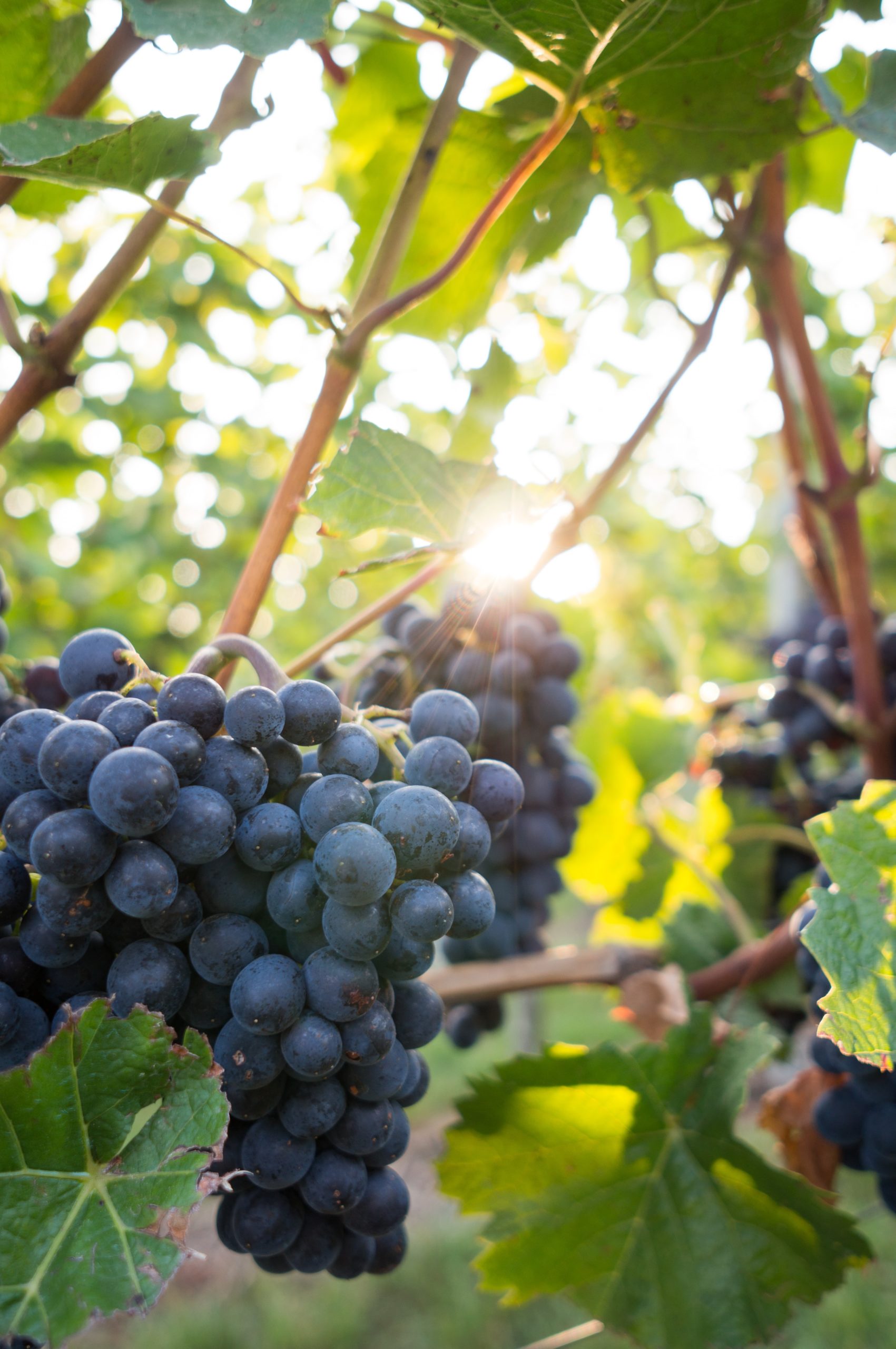Pinot Noir Programme Research Aims 2.5 and 2.6 Vine and Wine Ideotypes
Vintage by vine interactions most strongly influence Pinot noir grape and wine composition in New Zealand
Damian Martin, Franzi Grab, Claire Grose, Lily Stuart. The New Zealand Institute for Plant and Food Research Limited, Marlborough.
Claire Scofield. The New Zealand Institute for Plant and Food Research Limited, Clyde.
Tanya Rutan. Bragato Research Institute, Marlborough.
Aims: Industry doctrine dictates that Pinot noir wine quality attributes are predominantly determined by grape composition. Our study attempts to understand the relationship between grape (and ultimately wine) composition and the physical appearance and performance characteristics of a vine (i.e. vine ideotype). The long-term commercial goal is to derive optimised vine specifications tailored to the production of a desired Pinot noir wine type.
Methods and Results: Vine genetics, fruit maturity, region and vineyard are perceived by producers and consumers as factors that strongly influence Pinot noir wine composition. Our experimental approach controls these variables by studying within-block differences in vine performance across multiple seasons and vineyards in order to understand how factors such as season and vine attributes (e.g. yield) affect wine composition.
Grapes were sourced at commercial harvest from 20 single-vines from 12 vineyard sites in three Pinot noir growing regions (Central Otago, Martinborough and Marlborough) of New Zealand. Each season a total of 220 individual Pinot noir vines of a single clone and rootstock combination comprised the study population. Across the 2018 and 2019 vintages the same 20 vines within each vineyard were monitored. A subset of approximately 20% of the vines were selected for winemaking as single-vine lots. The selected vines displayed a wide range of yields and provenances but grape maturity was within a narrow range.
Per vine yields ranged from less than 0.1 kg to nearly 6.9 kg. At the time of commercial harvest there was no general relationship between yield and berry soluble solids, neither within the full sample set nor within each site. On a vine by vine basis the block-normalised yield did not correlate between seasons. In the same way there was no relationship for berry soluble solids between seasons nor was there any relationship for berry colour between seasons on a vine by vine basis.
There was a striking increase in phenolic content and colour of the berries between 2018 and 2019, even with the same fruit yield per vine. The total phenolic content increased 2.5-fold and colour was, on average, three-fold higher.
From the total population of vines studied in 2019 there were only 12 of 220 (5%) that reached a good technological maturity at yields of approximately 9 t/ha or more. While Pinot noir grape and wine quality was high in 2019, the performance of the vineyards in this study could still be viewed as commercially sub-optimal.
Unlike 2018, low vineyard yield was the principal contributor to under-performance, but there is no evidence in our data to suggest that had yield been higher in 2019, other fruit compositional attributes would have suffered.
Wines made in 2019 typically showed more than double the colour (both OD520 and colour density) than those made at the same yield by soluble solids band in 2018. Wine total phenolic content was also elevated in 2019, but results indicated that the increase was largely because of an increase in red pigmented phenolics rather than in wine tannins. Differences in berry mass contributed to a large range in the marc:wine ratio (M:W), but our data suggest other unknown factors also affect M:W. While an average 35% reduction in berry size in 2019 contributed to the more intensely coloured wines, the berry size difference alone does not explain the remarkable lift in colour between vintages.
Across the sample set, and unlike 2018, there was a general negative relationship between vine yield and wine colour/phenolic content. This relationship was, however, highly leveraged by wines from a single site, which presented higher yields, large berries and relatively low (but still superior to 2018) wine colour. When sufficient within-site replication was obtained (N ≥ 4) the negative relationship between vine yield and wine colour was not observed between vines within the same block. These results are supported by the berry colour data and suggest that higher yield and high wine colour are not mutually exclusive. Overall, our data show that, at comparable yields and berry masses, wine total anthocyanin concentrations in 2019 were approximately twice those of 2018.
Our data also indicate an antagonistic relationship between wine phenolics and juice primary amino nitrogen, although in 2019 berry size and M:W ratio contributed to large residual variances resulting in a weaker negative correlation than in 2018.
Principal Component Analysis (PCA) has shown that vintage is the predominant factor affecting vine parameters and berry, juice and wine compositional attributes. The vintage effect dominates compositional effects that might be associated with yield per vine, region and vineyard, albeit that vintage by vineyard interactions are evident. Data indicate an antagonistic relationship between wine phenolics and juice primary amino acid metabolisms, although berry size and juice:marc ratio contribute to large residual variances.

Figure 1. Principal Component Analysis (PCA) of vine, berry, juice and wine data from the Pinot noir Ideotype Vines single-vine lots selected for small-scale winemaking. The left biplot shows the scores of vine, berry, juice and wine parameters categorised by yield. The right biplot shows the vector loadings of the measured physiological and chemical parameters.

Figure 2. Principal Component Analysis (PCA) of vine, berry, juice and wine parameters categorised and clustered by vintage.
Conclusions: The extent of the variation in performance of the same vines between seasons largely excludes factors that are stable between seasons as primary causes. Variation in management of the same vine from year to year (especially bud load) seems the most likely management contributor to performance variation. Vintage is the predominant factor affecting vine parameters and berry, juice and wine compositional attributes, greatly overriding effects that might be associated with yield per vine, region and vineyard.
Significance and Impact of the Study: Our wider Pinot noir research effort currently uses in vitro berry growth and controlled environment potted vine studies to unravel the underlying causes of differences in berry composition. After multiple seasons of study we can, however, progress our programme confident in the knowledge than factors such as vine yield, region or vineyard are, in themselves, unlikely to be the principal drivers of major differences in Pinot noir grape and wine composition. That is not, however, to say that fine differences in wine composition (yet to be measured) are not extremely important in determining the style, quality and price of Pinot noir wine.
Acknowledgements: The authors would like to thank the 11 participating wine companies for providing the study sites. This type of research is made possible by the intellectual contributions and passion of winemakers and viticulturists. Thanks also to Mark Langlands of Vinemanagers Ltd for assistance with data collection in the Wairarapa. This study is funded by Bragato Research Institute through a Ministry of Business, Innovation and Employment Endeavour fund grant.
This article first appeared in the June/July 2020 issue of the New Zealand Winegrower Magazine.

















